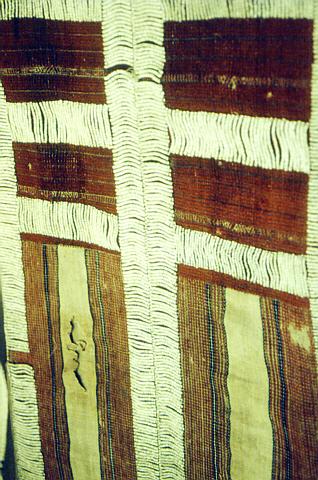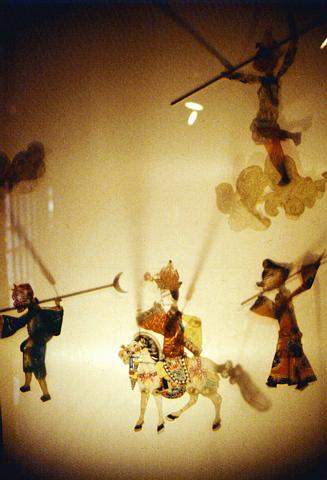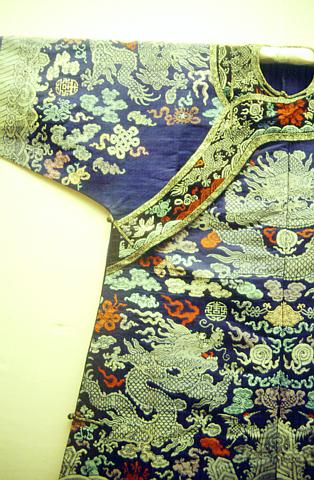From the moment you step out of your shoes and into a pair of slippers, you are carried back in time. Strolling past the courtyard garden, the creaking of the wood floor echos the history of the building's rich and diverse past. Indeed, this superb piece of architecture is itself as much a product of Taiwan's history as the unique collection it now houses.
Constructed in 1921 in a style inspired by Tang Dynasty architecture, the building was listed as a Grade 3 heritage site in 1988. Before its present incarnation as a museum, this tranquil hillside retreat with superb views of Peitou served as an officers' club during the Japanese Occupation, and was at one time home to a unit of kamikaze pilots. The Japanese influence remains strong, especially upstairs and in the adjacent teahouse.
At the end of World War II, the Japanese ceded the building to the Ministry of Foreign Affairs, which renamed it the Chiashan Guest House (

PHOTO: COURTESY OF TAIWAN FOLK ARTS MUSEUM
The museum began with a collection of some 3,000 pieces donated by private collector, Chang Mu-yang (
The first floor exhibitions are divided into Taiwan Folk Arts and Taiwan Aboriginal Culture. The former displays everyday folk artefacts and houseware commonly used by early Chinese inhabitants of Taiwan as well as a selection of glove puppets, a traditional puppet theater stage and an intricately carved 1933 bridal palanquin decorated with 150 figurines.
The Taiwan Aboriginal Culture section contains an exquisite collection of aboriginal textiles, one of the most treasured of which is an 1880 Atayal garment woven from ramie and shells, pictured above. There is also a fine selection of carvings, pottery, jewellery and basketry from different tribes, as well as examples of traditional dwellings.

PHOTO: COURTESY OF TAIWAN FOLK ARTS MUSEUM
Running the length of the corridor on the first floor, is a pictorial exhibit which traces Taiwan's history from the Late Palaeolithic Era right up to the elimination of the Provincial Government in 1998. Key moments along the way include the Dutch and Spanish invasions, the arrival of Koxinga; the 50 years of Japanese occupation, and the post-war period under the KMT.
Upstairs is reminiscent of a Japanese ryokan, or guesthouse, and the former banquet room still contains the stage where Japanese officers were once entertained. Should you find yourself there on a hot summer's day, you may well have to resist the temptation to stretch out on the tatami.
The second floor houses one of the island's largest collections of female Chinese clothing dating from 1860-1945. Brought to Taiwan by female immigrants during the Qing Dynasty, the traditions of Chinese apparel, although incorporating some local influences, remained largely unaffected until the 1920s despite the Japanese policy of assimilation. There are 200 items on permanent display, including many finely preserved examples of jackets, skirts, trousers, collars, undergarments and lotus slippers, all painstakingly embroidered with delicate motifs.

PHOTO: COURTESY OF TAIWAN FOLK ARTS MUSEUM
There is also an array of silver hairpins and other accessories, spectacle cases, tobacco pouches and mandarin squares.
The smaller of the two upstairs rooms is used for special theme exhibitions, which are rotated periodically. As part of the ongoing series titled My Favorites Stored at Home, the museum is currently displaying a collection of everyday household objects from the period of Japanese occupation under the heading of Do You Know Who I am?
The visitor is encouraged to participate by making a guess at the object's function before referring to the explanation. At first glance, some items appear to be a little more obvious than others. One object resembling a large spoon, for example is, in fact, just that. However, the fact that it was designed to feed medicine to a cow is not so immediately apparent.

PHOTO: COURTESY OF TAIWAN FOLK ARTS MUSEUM
The series also includes an elegant reconstruction of a woman's boudoir, consisting of pieces of European Baroque furniture commonly used by wealthy doctors and merchants between 1895-1945 (See picture). The third part of the series will begin on July 8.
Exhibits throughout the museum are clearly annotated in Chinese and English, and supplementary information on folk artefacts, traditional dress and aboriginal culture is available in Chinese, English and Japanese.
As part of the museum's community outreach policy, it also periodically runs folk art activities and craft workshops, and has begun collaborating with three other small-scale museums in the area to share resources, namely Hong-gah Museum (
FOR YOUR INFORMATION:
Taiwan Folk Arts Museum (
DIRECTIONS:
From Hsin Peitou (
Shann Garden (
Located in a Japanese-style building next door to the Taiwan Folk Arts Museum, Shann Garden offers a variety of European, Chinese and Mongolian cuisine as well as its own teahouse. Tel 2896 5700, ext 201-2. 11:30am to 2pm and 5:30 to 9:30pm, Monday to Friday; 11:30am to 2:30pm and 5:30 to 9:30pm Saturday, Sunday and holidays.

June 2 to June 8 Taiwan’s woodcutters believe that if they see even one speck of red in their cooked rice, no matter how small, an accident is going to happen. Peng Chin-tian (彭錦田) swears that this has proven to be true at every stop during his decades-long career in the logging industry. Along with mining, timber harvesting was once considered the most dangerous profession in Taiwan. Not only were mishaps common during all stages of processing, it was difficult to transport the injured to get medical treatment. Many died during the arduous journey. Peng recounts some of his accidents in

“Why does Taiwan identity decline?”a group of researchers lead by University of Nevada political scientist Austin Wang (王宏恩) asked in a recent paper. After all, it is not difficult to explain the rise in Taiwanese identity after the early 1990s. But no model predicted its decline during the 2016-2018 period, they say. After testing various alternative explanations, Wang et al argue that the fall-off in Taiwanese identity during that period is related to voter hedging based on the performance of the Democratic Progressive Party (DPP). Since the DPP is perceived as the guardian of Taiwan identity, when it performs well,

The Taiwan People’s Party (TPP) on May 18 held a rally in Taichung to mark the anniversary of President William Lai’s (賴清德) inauguration on May 20. The title of the rally could be loosely translated to “May 18 recall fraudulent goods” (518退貨ㄌㄨㄚˋ!). Unlike in English, where the terms are the same, “recall” (退貨) in this context refers to product recalls due to damaged, defective or fraudulent merchandise, not the political recalls (罷免) currently dominating the headlines. I attended the rally to determine if the impression was correct that the TPP under party Chairman Huang Kuo-Chang (黃國昌) had little of a

A short walk beneath the dense Amazon canopy, the forest abruptly opens up. Fallen logs are rotting, the trees grow sparser and the temperature rises in places sunlight hits the ground. This is what 24 years of severe drought looks like in the world’s largest rainforest. But this patch of degraded forest, about the size of a soccer field, is a scientific experiment. Launched in 2000 by Brazilian and British scientists, Esecaflor — short for “Forest Drought Study Project” in Portuguese — set out to simulate a future in which the changing climate could deplete the Amazon of rainfall. It is